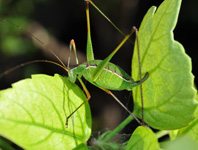Abstract
To date, 22 species of amphisbaenids have been recorded at Brazilian Amazon (Ribeiro et al. 2008), six of them are small and have two pre-cloacal pores (Hoogmoed & Ávila-Pires 1991; Teixeira Jr. et al. 2014). Most of these species have narrow distributions, and its biology and phylogenetic relationships are poorly understood (Hoogmoed & Ávila-Pires 1991). Amphisbaena mitchelli Procter, 1923 and A. miringoera Vanzolini, 1971 share several morphological similarities that could reflect phylogenetic relatedness (Vanzolini 1971). Both have two pre-cloacal pores and a similar pattern of head scutelation, but whereas the first has 193–220 and 26–29 body and tail annuli, respectively, the latter has 250–264 and 22–24 (Vanzolini 1971).
References
Darriba, D., Taboada, G.L., Doallo, R. & Posada, D. (2012) jModelTest 2: more models, new heuristics and parallel computing. Nature Methods, 9 (8), 772.
http://dx.doi.org/10.1038/nmeth.2109Gans, C. (1964) Amphisbaena mitchelli Procter registered from Belem, Pará, Brazil. Herpetologica, 20 (3), 192–194.
Gans, C. & Alexander, A.A. (1962) Studies on amphisbaenids (Amphisbaenia, Reptilia) 2. On the amphisbaenids of the Antilles. Bulletin of the Museum of Comparative Zoology, 128 (3), 65–158.
Hall, T. (2011) BioEdit: an important software for molecular biology. GERF Bulletim of Biosciences, 2 (1), 60–61.
Hoogmoed, M.S. & Ávila-Pires, T.C.S. (1991) A new species of small Amphisbaena (Reptilia: Amphisbaenia: Amphisbaenidae) from western Amazonian Brazil. Boletim do Museu Paraense Emílio Goeldi, Série Zoologia, 7 (1), 77–94.
Huelsenbeck, J.P. & Ronquist, F. (2001) MRBAYES: Bayesian inference of phylogenetic trees. Bioinformatics, 17 (8), 754–755.
http://dx.doi.org/10.1093/bioinformatics/17.8.754Miller, M.A., Pfeiffer, W. & Schwartz, T. (2010) Creating the CIPRES Science Gateway for inference of large phylogenetic trees. Proceedings of the Gateway Computing Environments Workshop, New Orleans, LA, 8pp.
Mott, T. & Vieites, D.R. (2009) Molecular phylogenetics reveals extreme morphological homoplasy in Brazilian worm lizards challenging current taxonomy. Molecular Phylogenetics and Evolution, 51 (2), 190–200.
http://dx.doi.org/10.1016/j.ympev.2009.01.014Mott, T., Neto, C.S.C. & Filho, K.S.C. (2011) Amphisbaena miringoera Vanzolini, 1971 (Squamata: Amphisbaenidae): New state record. Check List, 7 (5), 594–595.
Procter, J.B. (1923) On new and rare reptiles from South America. Proceedings of the Zoological Society of London, 93 (4), 1061–1068.
http://dx.doi.org/10.1111/j.1096-3642.1923.tb02220.xRibeiro, S., Vaz-Silva, W. & Santos-Jr, A.P. (2008) New pored Leposternon (Squamata, Amphisbaenia) from Brazilian Cerrado. Zootaxa, 1930, 18–38.
Sambrook, J. & Russel, D. (2001) Molecular cloning: a laboratory manual. 3. ed., Cold Spring Harbor Laboratory Press, Nova York.
Shimodaira, H. (2002) An approximately unbiased test of phylogenetic tree selection. Systematic Biology, 51 (3), 492–508.
http://dx.doi.org/10.1080/10635150290069913Shimodaira, H. & Hasegawa, M. (1999) Multiple comparisons of log-likelihood with applications to phylogenetic inference. Molecular Biology and Evolution, 16, 1114–1116.
http://dx.doi.org/10.1093/oxfordjournals.molbev.a026201Shimodaira, H. & Hasegawa, M. (2001) CONSEL: for assessing the confidence of phylogenetic tree selection. Bioinformatics, 17 (12), 1246–1247.
http://dx.doi.org/10.1093/bioinformatics/17.12.1246Stamakis, A. (2014) RAxML Version 8: A tool for phylogenetic analysis and post-analysis of large phylogenies. Bioinformatics, 30 (9), 1312–1313.
http://dx.doi.org/10.1093/bioinformatics/btu033Swofford, D.L. (2003) PAUP*. Phylogenetic Analysis Using Parsimony (*and other methods). Version 4. Sinauer Associates, Sunderland, Massachusetts.
Teixeira, JR., M., Dal Vechio, F., Neto, A.M. & Rodrigues, M.T. (2014) A New Two-Pored Amphisbaena Linnaeus, 1758, from Western Amazonia, Brazil
Amphisbaenia: Reptilia). South American Journal of Herpetology, 9 (1), 62–74.
http://dx.doi.org/10.2994/SAJH-D-14-00004.1Vanzolini, P.E. (1971) New Amphisbaenidae from Brazil (Sauria). Papéis Avulsos de Zoologia, 24 (14), 191–195.

